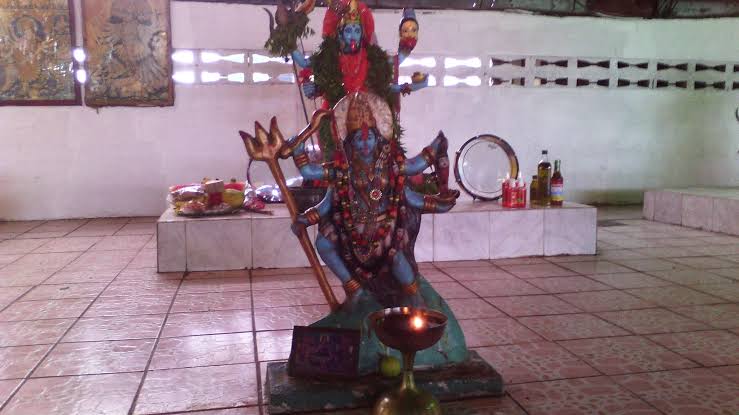Trinidad & Tobago : Kali Mai in mas

By
Dr Gabrielle Hosein
On Sunday the Express’s front-page photo featured Renella Alfred, who comes from the famous Alfred family from Couva, playing jab jab. The caption described her as the Whip Princess, sticking out her coloured tongue as part of her portrayal. However, this banal description failed to convey what Renella was bringing to town through her mas, which is her invocation of the Hindu goddess Mother Kali.
This is easy to miss unless you are thinking about Indianness in the Caribbean, and how it is being practised beyond the Sanskritisation of Hindu life as authorised by religious texts and authorities. It speaks to how Indian women in Trinidad and Tobago take up mas in ways that breathe life into post-indenture feminist legacies.
When Indians arrived in the Caribbean, they brought an eclectic range of cultural and religious practices, and a pantheon of goddesses whose spiritual power confronted European patriarchal belief systems, where God, Jesus, the Holy Spirit and disciples were conceived of as male. African religious traditions with, for example, a pantheon of female orishas such as Yemaya, Oshun and Oya, similarly offered an alternative cosmology of feminine divinity and energy.
Stereotypically, Hinduism and Carnival are cast as oppositional. One is associated with purity and the other with sin. However, mas making among Indians in TT tells a different story of mas being played to express a sense of spirituality, reverence for ancestry, devotion to discipline and respect for aesthetic forms of connection.
Among traditional mas makers, mas is a deeply sacred moral universe full of ritual, which is not opposed to being Indian or Hindu. In fact, mas making in the lives of Indo-Caribbeans weaves together all of these, brilliantly and creatively defining the afterlife of indenture, and redefining creolisation.
For Hindus who understand how village youth can play the sacred roles of Ram and Sita for Ramleela, mas becomes another stage for a leela (or play) about an epic journey and experience of exile, morality as it confronts the demonic, gender and sexual tensions, and legacies of Indian presence in the Caribbean.
The concept of “post-indenture feminist legacies” refers to the spiritual and cultural traditions, artefacts, myths, symbols and imagined possibilities brought from India in jahaji and jahajin bundles (creolised as “georgie bundle”) which, today, are being drawn on by women – and not just Indian women – to express feminine power and feminisms.
As Lisa Outar and I describe in the edited collection, Indo-Caribbean Feminist Thought, such woman-centred world-making articulates “a feminist praxis where Indian gendered experiences in the Caribbean are not marginal, while being understood in ways centred in a politics of solidarity across ethnicity, class, gender, sexualities, and nation” (2016, 2). Praxis describes more than action. It means action, portrayal or performance grounded in considered thought and reflection.
It is a profoundly philosophical contribution and, in the Caribbean, we don’t just do philosophy through lyrics and music. We do it through the sacred, and the clashing and combining of belief systems or cosmologies; through gender and sexuality, which has long been defined by struggle against authorities that demarcate the good, holy and respectable from the polluting, profane and improper; and through embodiment, or the pleasures of how we assert our right to exist, and affirm the value and joy of our sovereign selves, with our bodies.
The photo also showed her wearing a “nath” or nose ring with a chain connected to her hair. The nath is associated with bridehood and childbirth, and goddess Parvati, but also with Parvati’s incarnations as goddess Durga, a warrior goddess, and goddess Kali, who emerges from within Durga to destroy the demonic with her dance of destruction. The nath is also a symbol of Indian femininity, hardly seen outside of weddings and Divali, or in mas.
By naming herself the “Whip Princess,” Renella has elevated her royal status in mas “lore” as above that of secular law, challenging the State’s monopoly over violence. She is also defying male religious prerogative over when and how she can be Indian, woman and Hindu. Finally, she is douglarising Carnival, continuing an Indian presence that shaped sokah itself.
All that I have described and more is in Renella Alfred’s sacred invocation of Mother Kali in Carnival. Such combining is important because many of our ancestors were brought to be violently exploited and dehumanised in what was meant to be a labour and conversion camp. Yet, in such mas is also our painstaking crafting of a society of beautiful, powerful, equal and free human beings.
Diary of a mothering worker




